Going underground: The world's best subterranean sites
As the world's largest underground zip line opens in Wales, we round up the world's best subterranean attractions - from crystal caves in Mexico to buried Sri Lankan temples.
1) Zip World Caverns, Wales
The latest in a string of innovative adrenaline activities to spring up in North Wales, Zip World Caverns, an underground zip wire course, is probably the world’s first attraction to simultaneously induce acrophobia and claustrophobia. The former slate quarry has been converted into a subterranean assault course, with a series of zip wires, balance beams and rope bridges spanning the cavern’s precipices, some of which are large enough to fit 75 double-decker buses.
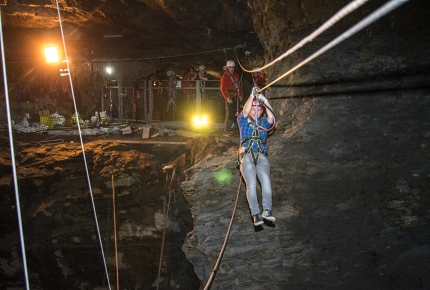 Zip wires help visitors traverse the caverns
Zip wires help visitors traverse the cavernsZip World
2) Hang En Cave, Vietnam
Vietnam’s Hang En cave is so mammoth in scale that it houses its own microclimate, shrubland and hidden idyllic beach. Gnarled fossils jut out from the limestone walls, and each evening hundreds of chirping swifts dart between dripping stalactites. However, this slice of underground Eden does not come easy. Located in the heart of the Phong Nha-Ke Bang National Park, intrepid adventurers must trek for around two days to reach the cavern, navigating through dense jungle and leech-infested rivers.
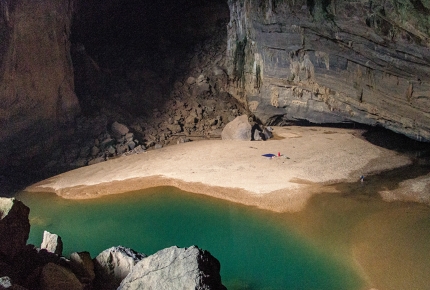 It's possible to camp on the cave's tiny 'beach'
It's possible to camp on the cave's tiny 'beach'Creative Commons / Hugh Derr
3) The Real Mary King’s Close, Scotland
Give the crowds the slip on Edinburgh’s Royal Mile and step into the subterranean world of Mary King’s Close. Once one of the city’s most vibrant neighbourhoods, the authorities partially demolished the close in the 18th century to make way for the Royal Exchange, which was built on top of it. Today visitors can walk around what remains of Mary King’s Close with costumed guides who give a warts ‘n’ all insight into the history of the city, complete with murderous tales and ghost stories.
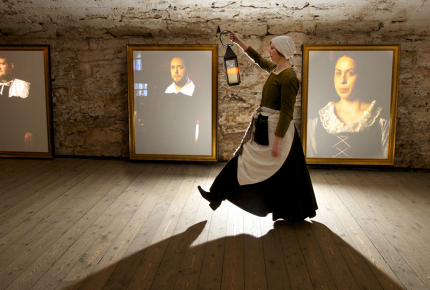 This buried neighbourhood in Edinburgh harbours gruesome secrets
This buried neighbourhood in Edinburgh harbours gruesome secretsThe Real Mary King's Close
4) Blackwater rafting, New Zealand
A giant black car inner tube is your trusty vessel as you float, plunge and swirl through the intriguing underground network of waterways at New Zealand’s Waitomo Caves. Rafters tackle subterranean waterfalls, squeeze down tiny tunnels and glide peacefully through ancient limestone formations, the inky black above illuminated by constellations of twinkling glowworms. Extreme as underground rafting may sound, this is a far gentler ride than whitewater rafting, and certainly not exclusive to the super-sporty.
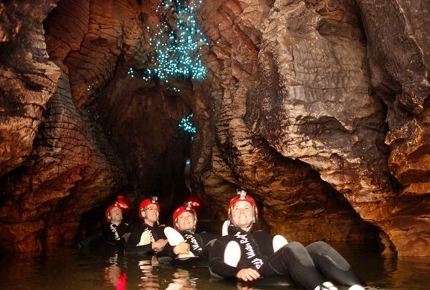 The caves are illuminated by glowworms
The caves are illuminated by glowwormsThe Legendary Black Water Rafting Co
5) Cahoots cocktail bar, England
In its former incarnation this subterranean space beneath Soho was used to shelter Londoners during the Blitz, today it’s a swanky cocktail bar taking punters back to the bittersweet days of post-war Britain. Designed to resemble an old Underground station, Cahoots opened earlier this year and serves pokey cocktails in old tube carriages. It’s all 1940s themed down here (except the prices), with bartenders wearing period garb and old newspapers giving you the stories from 1946. It’s a fine place for a few cocktails, but you’ll need to book ahead.
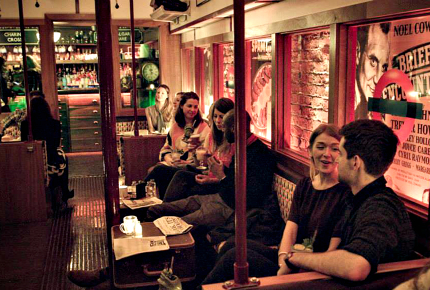 Once an air raid shelter this subterranean space is now a cocktail bar
Once an air raid shelter this subterranean space is now a cocktail barCahoots
6) Underground mountain biking, Slovenia
Mountain biking takes a new slant with this 5km (3-mile) bike tour through Slovenia’s Mount Peca. Old abandoned mining tunnels are the cycle path into this alpine giant, leading a seemingly impossible passage through the tightly packed rock. On meeting at the Mežica Mining Museum to be kitted out with the necessary equipment, cyclists are shuttled to the mine entrance 2km (1.2 miles) away, where lead ore was once heaved from the earth, to begin the journey into the mountain.
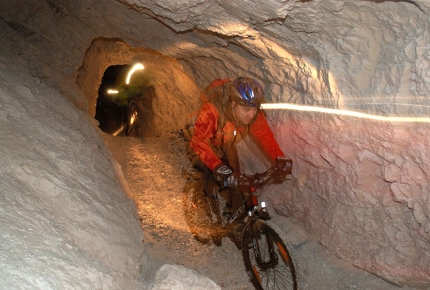 Take your love of cycling to new depths
Take your love of cycling to new depthsMountain Bike Nomad
7) Salina Turda theme park, Romania
Excavated by hand since the 13th century – although perhaps as early at 1075 – the massive Turda Salt Mine in Transylvania is now home to a very futuristic-looking subterranean theme park. The 112m-deep (368ft) park includes a Ferris wheel, a mini-golf course, bowling lanes, basketball hoops and an underground lake you can go boating on. Those with allergies and asthma should also try the mine’s halotherapy spa facilities, which use ionized air, pressure and humidity in the salt-lined caves to treat persistent respiratory problems.
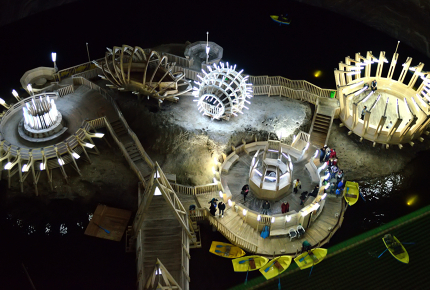 This old salt mine is now home to an underground theme park
This old salt mine is now home to an underground theme parkCreative Commons / c.lucian
8) Cave diving, Mexico
The Yucatan Peninsula’s Riviera Maya has more spots for cave diving than anywhere on Earth. For dark and mysterious dives complete with otherworldly rock formations and fantastical marine life, the Yucatan has it well and truly covered. The caves and cenotes (limestone sink holes) here were thought sacred by the indigenous Maya people, and today are increasingly protected. Well-qualified dive schools and instructors throughout the area teach divers how to respect this delicate underwater landscape.
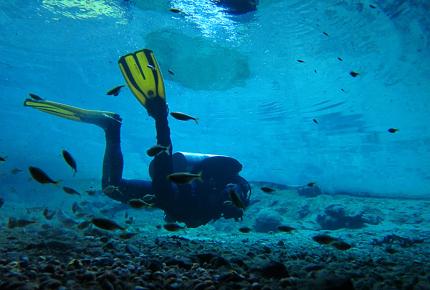 The Yucatan Peninsula is perfect for cave diving
The Yucatan Peninsula is perfect for cave divingCreative Commons / Asbjorn Hansen
9) The Paris Catacombs, France
Deep underneath Montparnasse lies a 320km (200-mile) network of old caves, tunnels and quarries turned macabre resting ground for the remains of some six million Parisians, including victims of the French Revolution. Also dubbed the world’s largest grave, the eerily quiet subterranean labyrinth is filled with neatly stacked skulls and bones that were exhumed from 1786 to 1860 to relieve overcrowded city cemeteries. A fascinating, if rather morbid, sight.
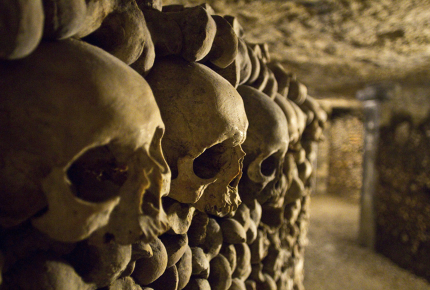 The Paris Catacombs hold the remains of some six million people
The Paris Catacombs hold the remains of some six million peopleBeccaVogt / Thinkstock
10) The Mine Suite, Sweden
Surrounded by dark winding galleries and caverns, and accessed via a mine lift shaft, this is the world’s deepest hotel room at 155m (508ft) below ground. A stay here comes with a guided tour of the Sala silver mine (which for at least 400 years was Sweden’s most important silver producer), as well as fizz on arrival and breakfast in bed. It gets a little chilly down here (2°C/35°F), so cover up for the tour, but thankfully the temperature in the actual room is a balmy 18°C (64°F). And all this for the modest price of 4,890 SEK (£375) for two.
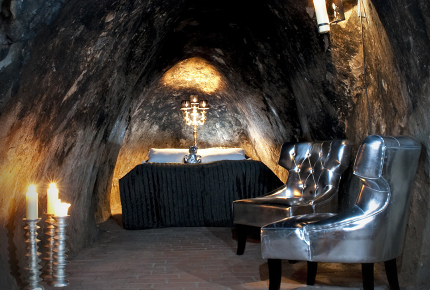 Sweden's Mine Suite is the world's deepest hotel room
Sweden's Mine Suite is the world's deepest hotel roomPappilabild
11) Salt Cathedral of Zipaquirá, Colombia
Carved out of a Zipaquirá salt mine, around two hours from Bogotá, this magnificent cathedral is made purely of salt. Located 180m (590ft) underground, the three-nave church opened in 1995 and has an impressive dome, religious statues sliced from salt and a Narthex labyrinth. With four chapels and UNESCO World Heritage recognition, the Wieliczka Salt Mine in Poland has also garnered the nickname, the Underground Salt Cathedral. This vast space is over 287km (178 miles) in length, runs as deep as 327m (1,073ft) and comes complete with a wellness centre and salt chandeliers.
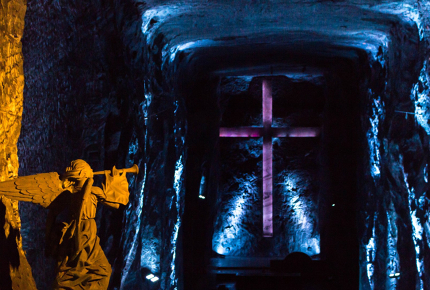 The Salt Cathedral of Zipaquira is 180m (590ft) underground
The Salt Cathedral of Zipaquira is 180m (590ft) undergroundCreative Commons / Jussi Ollila
12) Cabinet War Rooms, England
This secret underground bunker – beneath the streets of Westminster in London – was the nerve centre of the British war effort during WWII. See where Prime Minister Winston Churchill and his inner circle plotted the route to allied victory in a series of historic rooms filled with preserved 1940s artefacts – from wall maps covered in pins indicating changing front lines to the very swivel chair Churchill sat in while presiding over the War Cabinet.
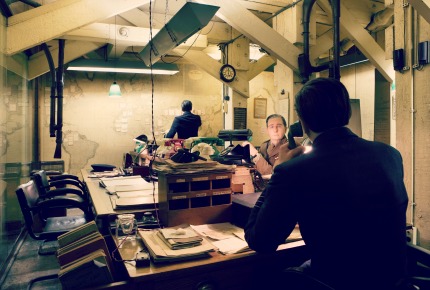 This war bunker sheltered Churchill and his men during the Blitz
This war bunker sheltered Churchill and his men during the BlitzIWM London
13) Dambulla Cave Temple, Sri Lanka
Buried beneath the vast bloated brown granite of Dambulla, Sri Lanka, awaits a much prettier affair: its sacred cave temples. A holy pilgrimage site for Buddhists for 22 centuries, the complex is a beguiling collection of caverns, religious murals and spiritual statues. Driven from Anuradhapura in the first century BC, King Valagamba originally came here to hide but soon converted the caves into temples. Elaborated and reconditioned by rulers in the 11th, 17th and 18th centuries, there are five main caves to visit but the Devaraja Viharaya is the best with its 14m-long (46ft) reclining Buddha carved from rock.
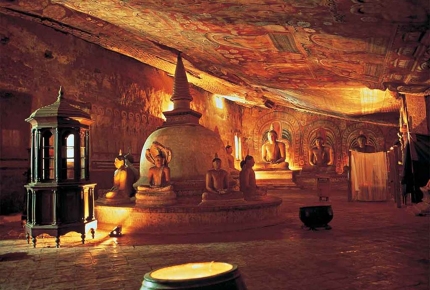 This cave temple has been a pilgrimage site for 22 centuries
This cave temple has been a pilgrimage site for 22 centuriesCreative Commons / Amila Tennakoon
14) Coober Pedy, Australia
The remarkable town of Coober Pedy, located in the harsh outback of South Australia, came into existence as a mining town after opals were discovered in the area in 1915. Due to the scorching summers, workers found it more preferable to live in houses built below ground level that helped to keep the temperature cool. Today, like some kind of post-apocalyptic cult, over 1,500 residents still live in the remote underground city, which includes hotels, a church and graveyard, a golf course and its own Aussie rules football team.
 The subterranean town includes hotels and a church
The subterranean town includes hotels and a churchCreative Commons / Werner Bayer
15) Olympic Cavern Hall, Norway
Mystical Scandinavian folklore was the inspiration behind this vast sports complex carved into the depths of a mountain in Gjøvik, Norway. Initially built for the 1994 Winter Olympics, it’s now home to local ice hockey team Gjøvik Hockey, and resumes international duties next year as a venue for the 2016 Winter Youth Olympics. The Gjøvik complex is the world’s largest subterranean cavern built for public use and it’s also tipped as a fail-safe hideout in the event of nuclear war. Good to know.
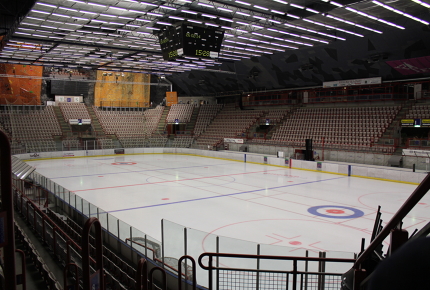 The innovative design keeps the ice rink naturally cool
The innovative design keeps the ice rink naturally coolWikimedia Commons / Øyvind Holmstad
16) Cu Chi Tunnels, Vietnam
Cu Chi was Veit Cong (VC) stronghold during the Vietnam War, which ended 40 years ago this year, but without the military might of either the Americans or the South Vietnamese, the VC had to think how to best outwit their enemy and get close to Saigon. They chose to build thousands of underground passages known as the Cu Chi Tunnels, which were instrumental for launching ambushes, creating supply routes and running an efficient guerrilla campaign. Now a tourist attraction, the tunnels give a great insight into the war and visitors can crawl through the underground passages themselves.
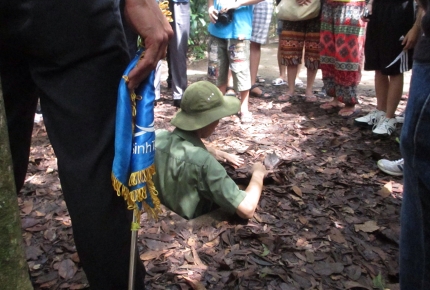 The Cu Chi Tunnels in Vietnam are now a tourist attraction
The Cu Chi Tunnels in Vietnam are now a tourist attractionDaniel Fahey
17) Bounce Below, Wales
Can you remember your parents warning you of the dangers of playing in old quarries? Well finally you can live out your rebellious teenage fantasies in the most defiant style imaginable. Bounce Below has transformed an old Welsh quarry cavern, roughly twice the size of St Paul's Cathedral, into a sanctuary for the young at heart. Massive trampolines are suspended over 26m (85ft) hair-raising drops, illuminated by psychedelic LED lighting. The space is open to people of all ages, stag and hen parties and even weddings.
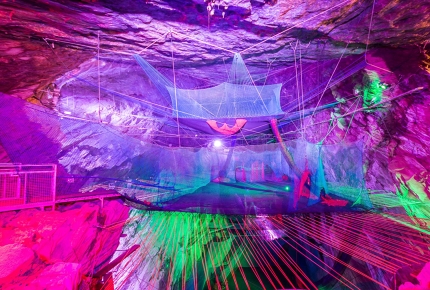 The large trampolines are suspended in mid-air
The large trampolines are suspended in mid-air Bounce Below
18) Derinkuyu underground city, Turkey
Hewn into the otherworldly landscapes of Cappadocia in Turkey, the subterranean city of Derinkuyu was built to protect Byzantine Greeks during the Arab-Byzantine wars (780-1180). The constant fear of invasion aside, the city’s 20,000 odd inhabitants lived happily with amenities such as schools, wineries, chapels and stables. Incredibly, the city was occupied as late as 1909, when Cappadocia Greeks sought refugee from marauding Ottomans. They held out for many years, but the region finally fell to the Turks in 1923 and the city was abandoned. Today it’s a tourist attraction.
 This underground city could accommodate some 20,000 inhabitants
This underground city could accommodate some 20,000 inhabitantsAlena Yakusheva / Thinkstock
19) Tunnels of Gibraltar, Gibraltar
Still a sore point between Britain and Spain, the Rock of Gibraltar is strategically located at the mouth of the Mediterranean and remains under British rule. Famous for its Barbary macaques, legend states that when these primates leave Gibraltar the British will follow, which is why Winston Churchill had more imported from Africa in 1942 to bolster the population. Life beneath “The Rock” is equally intriguing. Home to 55km (34 miles) of tunnels, these labyrinthine passageways were built by the British Army and housed hospitals, barracks and ammunition stores during WWII. Part of the network remains open to tourists.
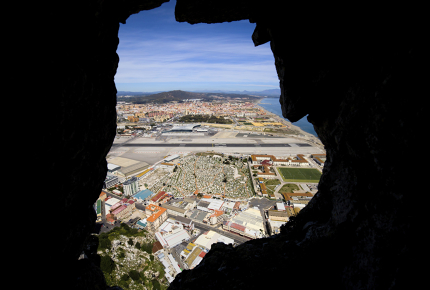 The view from secret tunnels hewn into the Rock of Gibraltar
The view from secret tunnels hewn into the Rock of GibraltarArtur Bogacki / Thinkstock
20) Radon Health Mine, USA
Originally a working mine for silver and lead ore in the 1920s, the Radon Health Mine shot to prominence in 1951 when an LA women discovered her bursitis disappeared after she visited the underground site. The effects of the radon in the mine were hailed as miracle cures and people started staying at the site to treat everything from arthritis to high blood pressure. Soon it grew into the Radon Health Mine, which is still in operation today and now offers radon therapy sessions for pets.
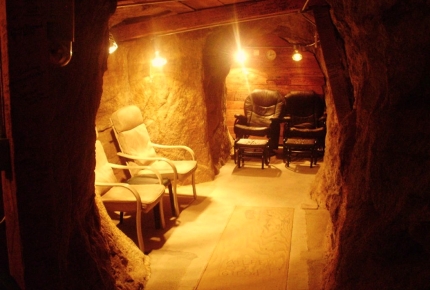 Radon Health Mine in Boulder, Montana is said to cure ailments
Radon Health Mine in Boulder, Montana is said to cure ailmentsCreative Commons / sporst
Do you have any Feedback about this page?
© 2025 Columbus Travel Media Ltd. All rights reserved. No part of this site may be reproduced without our written permission, click here for information on Columbus Content Solutions.









 You know where
You know where